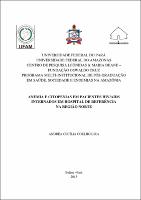| ???jsp.display-item.social.title??? |


|
Please use this identifier to cite or link to this item:
https://tede.ufam.edu.br/handle/tede/5760Full metadata record
| DC Field | Value | Language |
|---|---|---|
| dc.creator | Lira, Andréa Cecília Coelho | - |
| dc.creator.Lattes | http://lattes.cnpq.br/6124934453780527 | por |
| dc.contributor.advisor1 | Ribeiro, Rita de Cassia Mourinho | - |
| dc.contributor.advisor1Lattes | http://lattes.cnpq.br/4618732862010439 | por |
| dc.date.issued | 2013-09-16 | - |
| dc.identifier.citation | LIRA, Andréa Cecília Coelho. Anemia e citopenias em pacientes HIV/AIDS internados em hospital de referência na região norte. 2013. 70 f. Dissertação (Mestrado em Saúde, Sociedade e Endemias na Amazônia) - Universidade Federal do Amazonas, Universidade Federal do Pará, Belém, 2013. | por |
| dc.identifier.uri | http://tede.ufam.edu.br/handle/tede/5760 | - |
| dc.description.resumo | A AIDS é uma manifestação clínica avançada da infecção pelo vírus da imunodeficiência humana (HIV) e representa um dos maiores problemas de saúde da atualidade, em função do seu caráter pandêmico e de sua gravidade. A infecção pelo HIV apresenta diversos efeitos sobre a hematopoese, que se expressam no paciente por meio de anemia e citopenias, podendo decorrer do uso de drogas mielossupressoras, da invasão da medula por infecções oportunistas ou neoplasias, e até mesmo da interferência direta do HIV na hematopoese. Estudos mostram que pacientes HIV positivos apresentam maior comprometimento hematológico e metabólico, tornando-se, consequentemente, mais suscetíveis a infecções oportunistas características da AIDS, à progressão da doença e ao alto risco de morte. O objetivo desta pesquisa foi identificar as principais alterações hematológicas dos pacientes HIV/AIDS internados em hospital de referência da região norte, estimar a prevalência da anemia e de citopenias nesses pacientes e associar as alterações hematológicas desses pacientes com os principais achados clínicos, ao uso do AZT e com os antecedentes pessoais buscando identificar possíveis fatores de risco. Foi desenvolvido um estudo transversal descritivo prospectivo, onde a amostra constituiu-se de 34 pacientes. A maioria dos pacientes que internam com HIV/AIDS no HUJBB é do gênero masculino, com idade entre 31 e 45 anos, possuem o primeiro grau incompleto, e profissão autônoma. As alterações hematológicas mais prevalentes foram: anemia (93,5%), eritropenia em homens (100%), leucopenia (25,5%), linfopenia (54,8%), neutropenia (19,3%) e plaquetopenia (19,5%). A anemia foi a alteração hematológica mais prevalente, com destaque para o gênero masculino. Não foram encontradas associações significativas entre as alterações hematológicas e nenhum dos achados clínicos, uso de AZT e antecedentes pessoais (p>0,05). | por |
| dc.description.abstract | AIDS is an advanced clinical manifestation of the infection through the human immunodeficiency virus and represents one of the greatest current health problems, due to its pandemic character and gravity. Infection through HIV presents diverse effects over haematopoiesis, which express themselves on the patient through anemia and cytopenias, and may come from usage of myelosupressive drugs, marrow invasion by opportunistic infections or neoplasms, and even the direct interference of HIV on haematopoiesis. Studies show that HIV-positive patients display greater hematologic and metabolic compromise, consequently becoming more susceptible to opportunistic infections commonly found in AIDS, to progression of the disease and to a high risk of death. The objective of this research was to identify the main hematologic alterations of the HIV/AIDS patients hospitalized at recognized local hospitals in the northern region, to estimate the prevalence of anemia and cytopenias on those patients and to link their hematologic alterations to the main clinical findings, to the use of AZT and to their personal history, seeking to identify possible risk factors. A cross-sectional descriptive-prospective study was developed, with the sample consisted of 34 patients. Most of the patients hospitalized with HIV/AIDS at the HUJBB are men, with ages ranging from 31 to 45 years, have not finished middle school and are self-employed. The most prevalent hematologic alterations were anemia (93,5%), erythropenia on men (100%), leucopenia (25,5%), lymphocytopenia (54,8%), neutropenia (19,3%) and thrombocytopenia (19,5%). Anemia was the most prevailing hematologic alteration, especially for men. No significant connections between the hematologic alterations and any of the clinical findings, usage of AZT and personal history (p>0,05). | eng |
| dc.description.sponsorship | CAPES - Coordenação de Aperfeiçoamento de Pessoal de Nível Superior | por |
| dc.format | application/pdf | * |
| dc.thumbnail.url | http://tede.ufam.edu.br//retrieve/17262/Disserta%c3%a7%c3%a3o%20-%20Andr%c3%a9a%20Cec%c3%adlia%20C.%20Lira.pdf.jpg | * |
| dc.language | por | por |
| dc.publisher | Universidade Federal do Amazonas - Universidade Federal do Pará | por |
| dc.publisher.department | Faculdade de Ciências Agrárias | por |
| dc.publisher.country | Brasil | por |
| dc.publisher.initials | UFAM - UFPA | por |
| dc.publisher.program | Programa de Pós-graduação em Saúde, Sociedade e Endemias na Amazônia | por |
| dc.rights | Acesso Aberto | por |
| dc.rights.uri | http://creativecommons.org/licenses/by-nc-nd/4.0/ | - |
| dc.subject | Aparelho respiratório – doenças | por |
| dc.subject | HIV (vírus) | por |
| dc.subject | AIDS (Doença) | por |
| dc.subject.cnpq | CIÊNCIAS DA SAÚDE | por |
| dc.title | Anemia e citopenias em pacientes HIV/AIDS internados em hospital de referência na região norte | por |
| dc.type | Dissertação | por |
| Appears in Collections: | Mestrado em Saúde, Sociedade e Endemias na Amazônia | |
Files in This Item:
| File | Description | Size | Format | |
|---|---|---|---|---|
| Dissertação - Andréa Cecília C. Lira.pdf | 1.07 MB | Adobe PDF |  Download/Open Preview |
This item is licensed under a Creative Commons License





